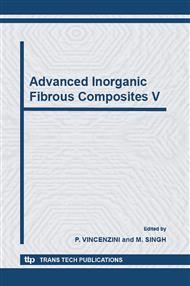p.24
p.31
p.37
p.46
p.51
p.57
p.64
p.75
p.83
Improved Oxide-Based Interfacial Coatings for the Next Generation of CMC's
Abstract:
CMC's reinforced by SiC-based fibers achieve high toughness and damage tolerance through the disposal of weak fiber coating which can deflect cracks and promote debonding at the fiber/matrix region. Refractory oxide-based systems are considered as the most promising ones for this purpose. Sols of zirconia, including stabilized zirconia were used as simple and readily processable precursors for obtaining interfacial coatings on SiC tow and cloth. The morphology, composition, topography, roughness, tensile properties of as-prepared and exposed to air at 1000°C coated fibers were evaluated by SEM/EDS, XPS, XRD, AFM, micro Raman analysis. The peculiarities of the behavior of oxide-coated fibers are governed by the properties of initial sols, procedure for coating fabrication, chemical and nanostructural factors. The peculiarities of the behavior of the stabilized zirconia interphase with accurate phase control will be discussed. A monitoring of the t→ m phase transformation within ZrO2 interfacial coating on SiC fiber using micro Raman makes it possible quantitatively to evaluate an ability of ZrO2 as oxidation resistance and readily deformable weak interfacial coating for the next-generation CMC's.
Info:
Periodical:
Pages:
51-56
Citation:
Online since:
October 2006
Authors:
Price:
Сopyright:
© 2006 Trans Tech Publications Ltd. All Rights Reserved
Share:
Citation:


